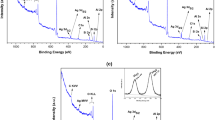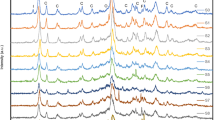We study the effect of activation of clinoptilolite specimens by the solutions of HCl, H2SO4 , NaOH, and NH4Cl with their subsequent thermal treatment for the sorption capacity in silver ions. It is shown that the highest sorption capacity is observed for the clinoptilolite activated by a sodium-hydroxide solution. It was established that, in all cases, the increment of sorption capacity observed upon attainment of a temperature of 200°С is insignificant. The rate of sorption of silver ions by clinoptilolite preliminarily activated by reagents is higher than the initial rate (without activation) by an order of magnitude. We also established the influence of the temperature of treatment of chemically activated clinoptilolite on the sorption rate of silver ions. It was shown that their absorption by clinoptilolite occurs according to the mechanisms of ion exchange and sorption.




Similar content being viewed by others
References
Z. V. Slobodyan, Z. M. Il’nyts’kyi, L. A. Mahlatyuk, R. B. Kupovych, and I. V. Semenyuk, “Ecologically safe inhibitors of the corrosion activity of lubricoolants,” Fiz.-Khim. Mekh. Mater., 54, No. 4, 48–51 (2018); English translation: Mater. Sci., 54, No. 4, 496–500 (2019).
I. M. Zin’, O. V. Karpenko, T. Ya. Pokyn’broda, N. I. Korets’ra, M. B. Tymus’, L. Kwiatkowski, and S. A. Kornii, “Inhibition of the corrosion of carbon steels by trehalose lipid surfactants,” Fiz.-Khim. Mekh. Mater., 54, No. 4, 31–38 (2018); English translation: Mater. Sci., 54, No. 4, 477–484 (2019).
A. M. Atta, G. A. El-Mahdy, H. A. Al-Lohedan, and A. O. Ezzat, “Synthesis and application of hybrid polymer composites based on silver nanoparticles as corrosion protection for line pipe steel,” Molecules, No. 19, 6246–6262 (2014); doi:https://doi.org/10.3390/molecules19056246.
R. Zeng, L. Liu, S. Li, Y. Zou, F. Zhang, Y. Yang, H. Cui, and E. Han, “Self-assembled silane film and silver nanoparticles coating on magnesium alloys for corrosion resistance and antibacterial applications,” Acta Metallurg. Sin., 26, No. 6, 681–686 (2013).
J. Narenkumar, P. Parthipan, J. Madhavan, K. Murugan, S. B. Marpu, A. K. Suresh, and A. Rajasekar, “Bioengineered silver nanoparticles as potent anticorrosive inhibitor for mild steel in cooling towers,” Environ. Sci. Pollut. Res. Int., 25, No. 6, 5412–5420 (2018).
A. M. Atta, H. A. Allohedan, G. A. El-Mahdy, and A-R. O. Ezzat, “Application of stabilized silver nanoparticles as thin films as corrosion inhibitors for carbon steel alloy in 1 M hydrochloric acid,” J. Nanomater. (2013), Article ID 580607; https://doi.org/10.1155/2013/580607.
A. S. Johnson, I. B. Obot, and U. S. Ukpong, “Green synthesis of silver nanoparticles using Artemisia annua and Sida acuta leaves extract and their antimicrobial, antioxidant and corrosion inhibition potentials,” J. Mater. Environ. Sci., 5, No. 3, 899–905 (2014).
L. A. Tamayo, P. A. Zapata, N. D. Vejar, M. I. Azócar, M. A. Gulppi, Х. Zhou, G. E. Thompson, F. M. Rabagliati, and M. A. Páez, “Release of silver and copper nanoparticles from polyethylene nanocomposites and their penetration into Listeria monocytogenes,” Mater. Sci. Eng., Ser. C, 40, No. 1, 24–31 (2014); https://doi.org/https://doi.org/10.1016/j.msec.2014.03.037.
E. A. Gonzáleza, N. Leivaa, N. Vejarc, M. Sancyb, M. Gulppia, M. I. Azócara, G. Gomeza, L. Tamayoe, X. Zhoud, G. E. Thompsond, and M. A. Páez, “Sol-gel coatings doped with encapsulated silver nanoparticles: inhibition of biocorrosion on 2024-T3 aluminum alloy promoted by Pseudomonas aeruginosa,” J. Mater. Res. Technol., 8, No. 2, 1809–1818 (2019).
O. V. Hres’, S. V. Holovan’, E. V. Lebedev, and V. F. Matyushov, “Acrylate silver dispersions and composite polymeric materials base on these dispersions,” Ukr. Khim. Zh., 75, No. 1, 63–67 (2009).
V. I. Pokhmurskyi, I. M. Zin, S. A. Kornii, Ya. I. Zin, and B. P. Kosarevych, “Theoretical and experimental prerequisites of the application of nanoporous ion-modified zeolites aimed at improvement of the protective properties of organic coatings,” Nanostrukt. Materialoznav., No. 1, 78–87 (2013).
N. M. Ahmed, H. S. Emira, and M. M. Selim, “Anticorrosive performance of ion-exchange zeolites in alkyd-based paints,” Pigment Resin Technol., 40, No. 2, 91–99 (2011); https://doi.org/https://doi.org/10.1108/03699421111113747.
S. A. S. Diasa, S. V. Lamaka, C. A. Nogueira, T. C. Diamantino, and M. G. S. Ferreirab, “Sol-gel coatings modified with zeolite fillers for active corrosion protection of AA2024,” Corr. Sci., No. 62, 153–162 (2012).
V. Pokhmurskii, L. Bily, Y. Zin, and M. Voloshyn, “Inhibition of the corrosion of aluminum alloy by a composition of ionexchange pigments,” Fiz.-Khim. Mekh. Mater., 51, No. 5, 43–47 (2015); English translation: Mater. Sci., 51, No. 5, 638–643 (2016).
V. D. Rybachuk, О. А. Ruban, and N. I. Filimonova, “Microbiological substantiation of the choice of concentration of antimicrobial substances in the composition of a powder based on natural zeolite (clinoptilolite),” Ukr. Biofarm. Zh., No. 1 (58), 4–9 (2019).
S. K. Pavelic, J. S. Medica, D. Gumbarevic, A. Filosevic, N. Przuli, and K. Pavelic, “Clinoptilolite safety and medical applications in vivo. Critical review on zeolite,” Front. Pharm., No. 9, 1–1350 (2018); https://doi.org/https://doi.org/10.3389/fphar.2018.01350.
L. Petrik, R. Missengue, O. Fatoba, M. Tuffin, and J. Sachs, Silver/Zeolite Nano-Composite-Based Clay Filters for Water Disinfection, Report to the Water Research Commission. WRC Report No. KV 297/12, Gezina ( 2012).
A. S. Hrabarovska, Z. O. Znak, and P. P. Olenych, “Investigation of the activation of natural clinoptilolite by ultrahigh-frequency electromagnetic radiation,” Khim. Tekhnol. Rechov. Zastos., 1, No. 2, 21–26 (2018).
Z. O. Znak, A. S. Hrabarovska, O. I. Zin, and A. V. Dyadenchuk, “Modification of thermally activated natural clinoptilolite with silver ions,” Visn. Cherkasy Derzh. Tekh. Univ., Tekh. Nauky, No. 4, 79–87 (2019).
Author information
Authors and Affiliations
Corresponding author
Additional information
Translated from Fizyko-Khimichna Mekhanika Materialiv, Vol. 56, No. 4, pp. 93–99, July–August, 2020.
Rights and permissions
About this article
Cite this article
Znak, Z.О., Коrnii, S.А., Маshtaler, A.S. et al. Production of Nanoporous Zeolites Modified by Silver Ions with Antibacterial Properties. Mater Sci 56, 536–543 (2021). https://doi.org/10.1007/s11003-021-00461-1
Received:
Published:
Issue Date:
DOI: https://doi.org/10.1007/s11003-021-00461-1




